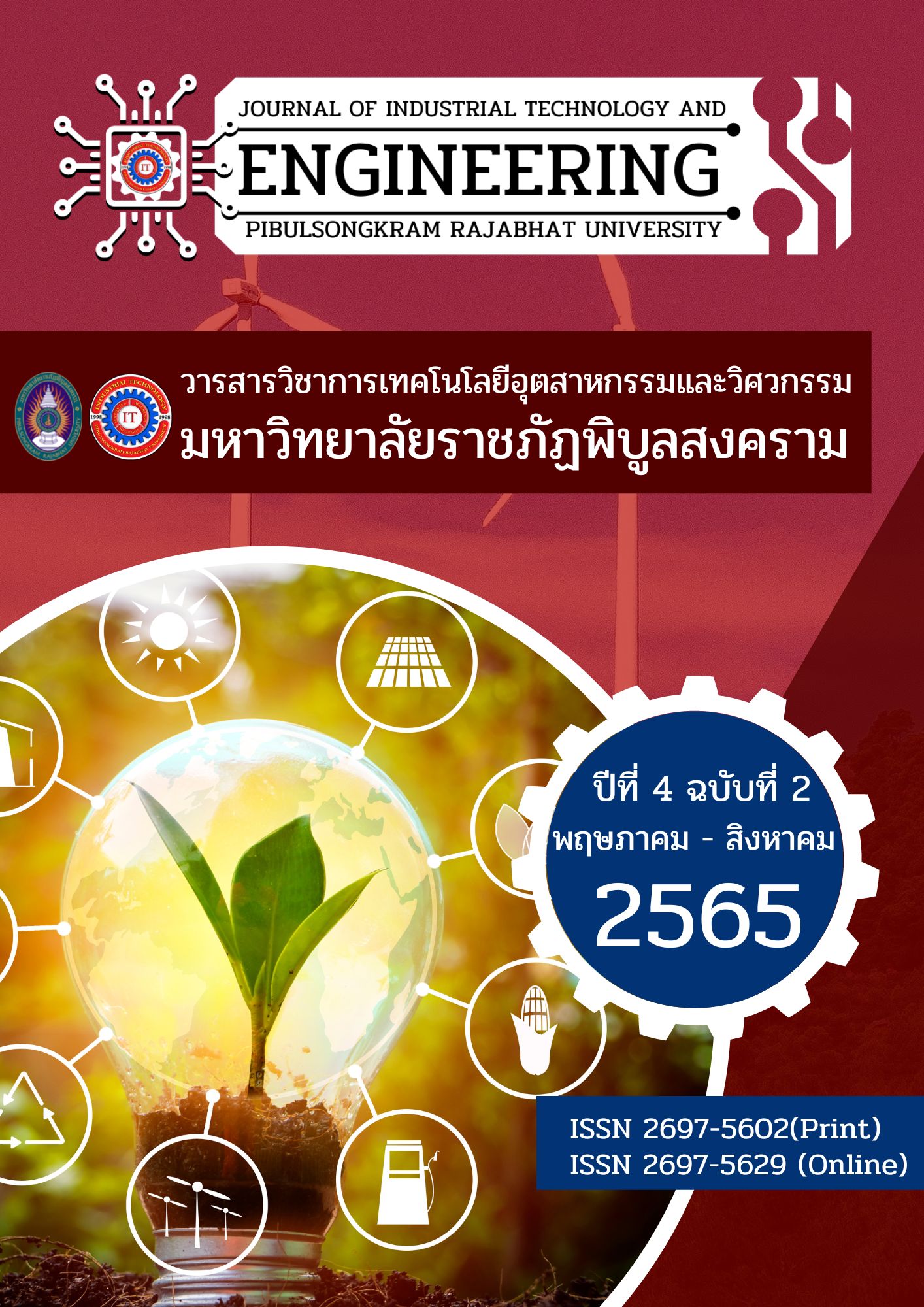การเพิ่มสมรรถนะเครื่องอบแห้งพลังงานแสงอาทิตย์
คำสำคัญ:
การควบคุมความชื้นสัมพัทธ์, เครื่องอบแห้งพลังงานแสงอาทิตย์, ประสิทธิภาพบทคัดย่อ
การอบแห้งเป็นกระบวนการลดความชื้นผลิตภัณฑ์เพื่อยืดอายุการเก็บรักษาและสร้างมูลค่าเพิ่ม ซึ่งเป็นที่ทราบกันดีว่ากระบวนการอบแห้งมีการใช้พลังงานค่อนข้างสูง ดังนั้นการพัฒนาเครื่องอบแห้งที่ใช้พลังงานทดแทนเป็นแหล่งผลิตความร้อนจึงมีความจำเป็น ด้วยเหตุผลดังกล่าวงานวิจัยนี้จึงได้ศึกษาการเพิ่มสมรรถนะเครื่องอบแห้งพลังงานแสงอาทิตย์ด้วยการควบคุมพัดลมระบายอากาศ ซึ่งมีเกณฑ์ที่ใช้ในการควบคุมการเปิด-ปิดพัดลมระบายอากาศคือผลต่างความชื้นสัมพัทธ์อากาศที่ทางเข้าและทางออกห้องอบแห้ง เครื่องอบแห้งพลังงานแสงอาทิตย์ที่มีเทคนิคการอบแห้งแตกต่างกัน 4 รูปแบบได้ถูกสร้างขึ้นเพื่อทดสอบสมรรถนะเครื่องอบแห้งพลังงานแสงอาทิตย์ไหลเวียนอากาศแบบธรรมชาติ (PSD) และเครื่องอบแห้งพลังงานแสงอาทิตย์ที่ติดตั้งชุดควบคุมความแตกต่างความชื้นสัมพัทธ์อากาศ 5% (SD-RH5), 10% (SD-RH10) และ 15% (SD-RH15) ตามลำดับ และได้เลือกเนื้อหมูที่มีความชื้นเริ่มต้นเท่ากับ 265±2%d.b. เป็นตัวอย่างในการทดลอง ซึ่งมีเกณฑ์ที่ใช้ในการประเมินสมรรถนะเครื่องอบแห้งพลังงานแสงอาทิตย์ ได้แก่ อัตราการอบแห้ง ประสิทธิภาพเครื่องอบแห้งพลังงานแสงอาทิตย์ และความสิ้นเปลืองพลังงานจำเพาะ ผลการศึกษาสามารถสรุปได้ดังนี้ 1) การควบคุมพัดลมระบายอากาศสามารถเพิ่มสมรรถนะเครื่องอบแห้งพลังงานแสงอาทิตย์ 2) สมรรถนะ SD-RH10 สูงกว่า SD-RH5, SD-RH15 และ PSD 3) อัตราการอบแห้ง SD-RH10 สูงกว่า SD-RH5, SD-RH15 และ PSD โดยเฉลี่ยประมาณ 1.93%, 3.38% และ 3.38% ตามลำดับ 4) ความสิ้นเปลืองพลังงานจำเพาะ SD-RH10 ต่ำกว่า SD-RH5, SD-RH15 และ PSD เฉลี่ยประมาณ 7.54%, 2.16% และ 1.86% ตามลำดับ และสุดท้ายประสิทธิภาพเครื่องอบแห้งพลังงานแสงอาทิตย์ PSD, SD-RH5, SD-RH10 และ SD-RH15 มีค่าเฉลี่ยประมาณ 8.47%, 8.11%, 8.68% และ 8.46% ตามลำดับ
เอกสารอ้างอิง
Ahmed, A.G. (2010). Design, construction and performance evaluation of solar maize dryer. Journal of Agricultural Biotechnology and Sustainable Development, 23, 39-46.
Ahmed, A.G. (2013). Drying characteristic of apple slices undertaken the effects of passive shelf solar dryer and open sun drying. Pakistan Journal of Nutrition, 12(3), 250-254.
Ankur, G.B., Das, A.B., & Jayanta, D.M. (2022). Sustainability and 4E analysis of novel solar photovoltaic-thermal solar dryer under forced and natural convection drying. Renewable Energy, 188, 1008-1021.
Aprajeeta, J., & Tripathy, P.P. (2021). Recent advancements in design, application, and simulation studies of hybrid solar drying technology. Food Engineering Reviews, 13, 375–410.
Avesahemad, S.N., Husainy, S.P., & Gouri, W. (2018). Experimental investigation of mixed mode forced convection solar dryer for turmeric (Curcuma Longa). Asian Review of Mechanical Engineering, 7(1), 1-6.
Aymen, E., Sami, K., Ilhem, H., & Abdelhamid, F. (2015). Experimental investigation and economic evaluation of a new mixed-mode solar greenhouse dryer for drying of red pepper and grape. Renewable Energy, 77, 1-8.
Baher, M.A.A, Klaus, G., & Hossain, M.A. (2018). Integrated hybrid solar drying system and its drying kinetics of chamomile. Renewable Energy, 121, 539-547.
Chaianong, A., & Pharino, C. (2015). Outlook and challenges for promoting solar photovoltaic rooftops in Thailand. Renewable and Sustainable Energy Reviews, 48, 356-372.
Chimres, N., & Wongwises, S. (2016). Critical review of the current status of solar energy in Thailand. Renewable and Sustainable Energy Reviews, 58, 198-207.
El-sebaii, A.A., & Shalaby, S.M. (2012). Solar drying of agricultural products: A review. Renewable and Sustainable Energy Reviews, 16, 37–43.
Gutti, B., Kiman, S., & Mustafa, B.G. (2012). Design and construction of forced/natural convection solar vegetable dryer with heat storage. ARPN Journal of Engineering and Applied Sciences, 7(10), 1213–217.
Hajar, E., Mohammed, B., Rachid, T., & Bargach, M.N. (2018). Experimental and theoretical analysis of drying grapes under an indirect solar dryer and in open sun. Innovative Food Science and Emerging Technologies, 49, 58-64.
Janjai, S., & Bala, B.K. (2012). Solar drying technology. Food Engineering Review, 4, 16–54.
Kapadiya, S., & Desai, M.A. (2014). Solar drying of natural and food products: A review. International Journal of Agriculture and Food Science Technology, 5(6), 565-576.
Karthikeyan, A.K., & Murugavelh, S. (2018). Thin layer drying kinetics and exergy analysis of turmeric (Curcuma longa) in a mixed mode forced convection solar tunnel dryer. Renewable Energy, 128, 305-312.
Khuthadzo, M., & Tilahun S.W. (2021). The kinetics of thin-layer drying and modelling for mango slices and the influence of differing hot-air drying methods on quality. Heliyon, 7, 1-15.
Kumar, A., Singh, R., & Prakash, O. (2014). Review on global solar drying status. Agricultural Engineering International: CIGR Journal, 16(4), 161-177.
Muruganantham, P.K., Kamalakannan, R.S., & Mohana, S. (2021). Performance analysis of a tubular solar dryer for drying mexican mint (Plectranthus amboinicus) - An experimental approach. Energy Reports, 7, 7–12.
Narendra, K.M., & Piyush, N. (2017). Review on solar energy dryer for drying the agricultural products. International Journal for Scientific Research & Development, 5(8), 198-203.
Nwajinka, C.O., & Onuegbu, C.U. (2014). Development of a solar cabinet dryer for root crops chips in Nigeria. Journal of Agricultural Engineering and Technology, 22(2), 47–58.
Okoroigwe, E.C., Eke, M.N., & Ugwu, H. U. (2013). Design and evaluation of combined solar and biomass dryer for small and medium enterprises for developing countries. International Journal of Physical Sciences, 8(25), 1341-1349.
Ortiz-Rodríguez, N.M, Condorí, M., Duran, G., & García-Valladares, O. (2022). Solar drying Technologies: A review and future research directions with a focus on agroindustrial applications in medium and large scale. Applied Thermal Engineering, 215, 1-31.
Semwanga, M., Nakiguli, F., & Nasejje, S. (2020). Drying performance and economic analysis of novel hybrid passive-mode and active-mode solar dryers for drying fruits in East. Journal of Stored Products Research, 88, 1-11.
Shrivastava, V., Kumar, A., & Baredar, P. (2014). Developments in indirect solar dryer: A review. International Journal of wind and Renewable Energy, 3(4), 67-74.
Sun, Y., Zhang, M., & Mujumdar, A. (2019), Berry drying: Mechanism, pretreatment, drying technology, nutrient preservation, and mathematical models. Food Engineering Reviews, 11, 61–77.
Vijayan, S., Arjunan, T.V., & Kumar, A. (2016). Mathematical modeling and performance analysis of thin layer drying of bitter gourd in sensible storage based indirect solar dryer. Innovative Food Science and Emerging Technologies, 36, 59–67.
Wei, W., Ming, L., Reda, H.E., Yunfeng, W., & Luwei. Y. (2018). Thermal performance of indirect forced convection solar dryer and kinetics analysis of mango. Applied Thermal Engineering, 134, 310–321.



